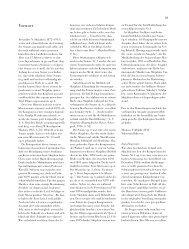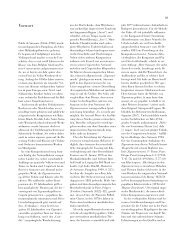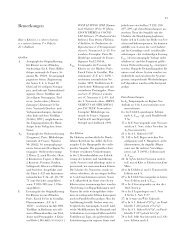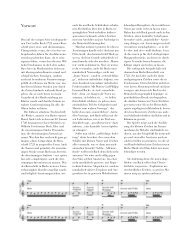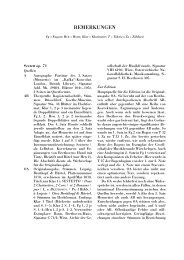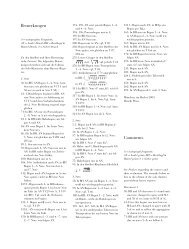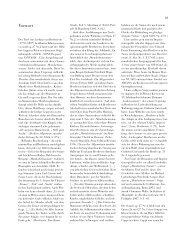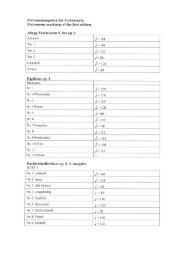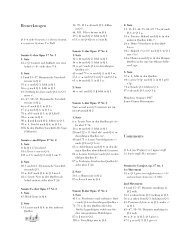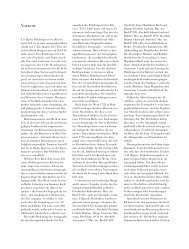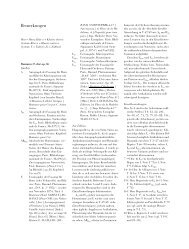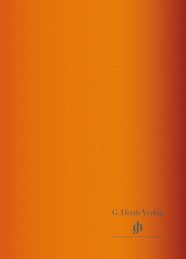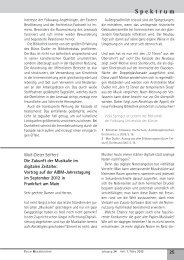Vorwort (PDF, 360 KB) - Henle Verlag
Vorwort (PDF, 360 KB) - Henle Verlag
Vorwort (PDF, 360 KB) - Henle Verlag
You also want an ePaper? Increase the reach of your titles
YUMPU automatically turns print PDFs into web optimized ePapers that Google loves.
these to triads. The remaining tones<br />
were then derived from intervals of a<br />
second, resulting in the following basic<br />
shape (starting on g):<br />
On 22 April 1935, during work on<br />
the earliest sketches, the death occurred<br />
from polio of the 18-year-old Manon<br />
Gropius, Alma Mahler-Werfel’s daughter<br />
from her marriage to the architect<br />
Walter Gropius. A letter from Helene<br />
Berg to Alma Mahler, written the very<br />
next day, only inadequately expresses<br />
the shock occasioned by this event: “We<br />
will not complain at God’s calling her<br />
back to him; for she was an angel” (in:<br />
Österreichische Musikzeitschrift 35,<br />
1980, p. 7). A short time later, Alban<br />
Berg adopted this same formulation, announcing<br />
the dedication of the work,<br />
whose form had recently been conceived:<br />
“I do not wish to try, in a letter,<br />
to find words where language fails […]<br />
But nevertheless: one day – even before<br />
this terrible year reaches its end – you<br />
and Franz [Werfel] will hear, in a score<br />
which will be consecrated to the memory<br />
of an angel, what I feel, and what today<br />
I can find no way of expressing” (in:<br />
Rosemary Hilmar, Katalog der Schriftstücke<br />
von der Hand Alban Bergs, der<br />
fremdschriftlichen und gedruckten Dokumente<br />
zur Lebensgeschichte und zu<br />
seinem Werk, Vienna, 1985, p. 126). It<br />
is, however, unclear whether this tragic<br />
event also had an influence on the structure<br />
or the course of the work (both the<br />
sketches for the form of the work, and<br />
for the note-row, are undated).<br />
Berg had from the outset intended to<br />
include musical quotations in the concerto,<br />
in order to also use them as motivic-thematic<br />
material. In the first<br />
movement this concerns the rustic-style<br />
melody (measures 213 ff.), which according<br />
to a note in connection with the<br />
first conception of the work was to take<br />
the form of “Var. [variations] on [a]<br />
Carinthian folksong.” Berg took the<br />
melody (and its accompanying countermelody)<br />
from the collection Wulfenia-<br />
Blüten. Einige fünfzig Lieder und Jodler<br />
aus Kärnten (ed. by Karl Liebleitner,<br />
Vienna, 1932, p. 35), which is printed<br />
there with the text “A Vögele af’n<br />
&<br />
w b w w Ì w w w w Ì w w Ì w<br />
Ì w<br />
Zweschpm-bam.” A compositional<br />
problem arose for Berg in regard to the<br />
introduction of the chorale in the second<br />
movement (he originally planned to use<br />
a melody of his own, derived from the<br />
tone-row). On 7 June he told Anton Webern<br />
in a fairly general way of his difficulties<br />
in this regard (“Perhaps the only<br />
thing on which I have, in the past three<br />
weeks, worked like a wild man … Has<br />
&<br />
n œ bœ<br />
n œ Ì œ n œ n œ n œ<br />
0 0 0 0<br />
Ì œ<br />
Ì w<br />
now stopped temporarily: a difficult<br />
rock has to be circumnavigated;” in:<br />
Rudolf Stephan, Berg. Violinkonzert<br />
(1935), Munich, 1988, p. 37), then on<br />
the following day he asked for concrete<br />
help from Willi Reich: “Please send me<br />
(on loan) the ‘St Matthew Passion’ (in<br />
full or vocal score), and, if you own one,<br />
a collection of chorales (I need a chorale<br />
melody for my work: be discreet!)” (in:<br />
Willi Reich, Alban Berg. Leben und<br />
Werk, Zurich, 1963, p. 93).<br />
In the edition sent to him of Sechzig<br />
Choralgesänge von Johann Sebastian<br />
Bach (edited by Herman Roth, Munich,<br />
1920, p. 58) Berg finally found, in the<br />
chorale Es ist genug! so nimm, Herr,<br />
meinen Geist, exactly the right cantus<br />
firmus. Not only was its text applicable<br />
to the circumstances surrounding the<br />
death of the concerto’s female dedicatee,<br />
but its opening whole-tone scale picked<br />
up the final notes of his tone-row, organised<br />
as a scale. (The chorale in question<br />
is the closing 5 th movement of<br />
Bach’s cantata O Ewigkeit, du Donnerwort<br />
BWV 60, composed in 1723 using<br />
a melody by Johann Rudolf Ahle). Berg<br />
himself must have been astounded by<br />
œ<br />
Ì œ<br />
bœ<br />
VII<br />
this amazing coincidence, for some<br />
weeks later, on 28 August 1935, he reported<br />
to Arnold Schönberg in connection<br />
with the form and the material underlying<br />
it: “I may tell you that the ‘violin<br />
concerto’ has been finished for fourteen<br />
days already. It has become bipartite,<br />
with each part in two movements:<br />
I a) Andante (Präludium) b) Allegretto<br />
(Scherzo) II a) Allegro (Cadenza)<br />
b) Adagio (chorale arrangement). I<br />
chose a particularly happy tone-row for<br />
the whole (since D-major and other<br />
such ‘violin concerto keys’ are out of the<br />
question), namely: [see music example<br />
below]” (Briefwechsel Arnold Schönberg<br />
– Alban Berg, ed. by Juliane<br />
Brand/Christopher Hailey/Andreas<br />
Meyer, Mainz, 2007, vol. 2, p. 571).<br />
n œ<br />
( n œ )<br />
&<br />
was zufälligerweise auch<br />
den Bach’schen Choralbeginn ergab<br />
# #<br />
# ##<br />
n œ<br />
Ì œ<br />
Ì œ<br />
„Es ist genug“<br />
Ì w<br />
In regard to the solo part, Berg enlisted<br />
the help of Louis Krasner – not only<br />
in regard to the successful realisation of<br />
the technical and sonic aspects of the<br />
challenging part, but also in respect of<br />
the general idiom of the instrument. So<br />
in late spring the two men met in Alban<br />
Berg’s forest home in Velden (Carinthia),<br />
a meeting which Krasner uncertainly<br />
dated to early June: “We had our<br />
coffee, and without delay he asked me<br />
to take my violin and play while he busied<br />
himself in and out the music room<br />
and about the house. I suggested the<br />
Concertos that I was then prepared to<br />
play – Glazunow, Brahms, Vieuxtemps,<br />
Tschaikovsky. ‘No,’ he said, ‘keine<br />
Konzerte,’ – no concertos. ‘Oh very well,<br />
a Sonata, – which Bach Sonata?,’ I<br />
asked. ‘Nein, nein, auch keine Sonaten!<br />
– no sonatas either. Just play – nur spielen<br />
– bitte, präludieren Sie einfach<br />
[please, just improvise],’ Berg replied.<br />
[…] After an hour or more when, without<br />
stopping, I lapsed into a section of a<br />
Concerto, Berg interrupted me and<br />
called from the other room, ‘Nein, nein,<br />
keine Konzerte, nur spielen – präludieren<br />
sie [sic] nur weiter – unbedingt!’



